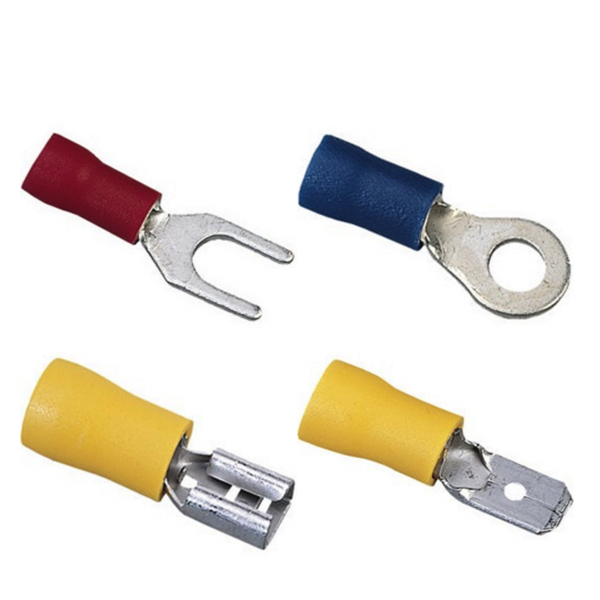Wire Terminals

Essential elements of electrical and electronic devices are the wire terminals, which are built to guarantee a good, safe, and reliable connection to and between wires and those devices. For many years, certain basic wire terminal styles have been around and in general use: those with rings, those with flat, notched spade-type ends, those with thin, flat "blade" ends.
Terminals are typically made from conductive materials like copper or brass, often plated with metals like tin. They hold wires in place while also ensuring efficient electrical current flow into and out of wires.
The most frequently used technique for attaching wire terminals is crimping. This involves using crimping tools to squeeze (or "crimp") the metal terminal around the stranded wire, both mechanically and electrically. Some terminals can also be soldered, for added reliability. Install wire terminals properly, and you'll get good, low-resistance, low-heat connections, which makes for both an effective and safe electrical system.
More Information about Wire Terminals
Disconnect Terminals
Disconnect terminals provide a reliable and convenient way to quickly connect and disconnect two wires using a male terminal on one end and complimentary female terminal on the other. They are ideal for applications that require the wires to connect and disconnect repeatedly. Many electronic devices and components have integrated disconnect connections to provide power and other signals.
Ring Terminals
Ring terminals are used to connect or terminate a single wire. The round end of the ring terminal makes an electrical connection with the help of a stud or a screw. The ring terminal is positioned over the circuit point where the flat surface of the ring makes the electrical connection. The screw is inserted into the circuit point, while going through the center of the ring terminal, and tightened into place.
Spade Terminals
Spade terminals or fork terminals are used to connect or terminate a single wire. The spade terminal makes an electrical connection with a screw, similar to a ring terminal, however, the open-ended spade terminal allows for a faster process because the screw can be left partially screwed in when the terminal is attached or removed.
FAQs
Are heat shrink terminals wire connectors that connect two or more wires?
Yes, heat shrink terminals are electrical terminals designed to connect two or more wires, providing a secure, insulated, and environmentally sealed connection once heated to shrink the tubing around the connection.
Industrial Wiring Tips and Tricks
Wire Type
MTW is typically used in industrial control panels. The flexibility of the wire allows it to be easily maneuvered through wire ducting. THHN wire is commonly found in homes or commercial buildings. The rigidity of the wire makes it easier to pull through conduit. XHHW wire is similar to THHN but provides a more protective insulation.
Wire Color
The National Electrical Code (NEC) or UL are great points of reference when trying to decide what colors of wire to use. For example, UL standard states that a ground wire should always be green, an AC hot or live wire should be black and AC neutral should be white. These are just a few examples of UL code requirements.
Wire Size
A simple rule of thumb when selecting wire size is, the higher the current, the larger the wire. It is also important to consider the bend radius of the wire. If a wire is bent too sharply, the conductors within the insulation can be damaged.
Wire Connection
It is important to make sure that the wire is connected properly and that enough torque has been applied. If enough torque is not applied to the electrical connection, the wire can become loose over time resulting in a poor electrical connection. Too much torque can damage the the wire and electrical equipment.
Wire Labels
Labeling is essential when performing any kind of electrical wiring. Proper labeling will allow others to easily identify the function of a wire, where it is going and where it has been. It can also make troubleshooting on a panel or any electrical device much easier when worked on at a later date.

